For decades, Sony’s gaming crop has yielded the greatest of harvests. From Sly Cooper to Uncharted, ICO to Metal Gear, Heavy Rain to Astro Bot, Sony and its partners have delivered quality goods from one generation to the next. Yet, while all PlayStation consoles have had their moments, one box has long cemented its place atop the pantheon of Sony royalty.
Of course, we’re talking about the PlayStation 2.
Between its unmistakable design, deep well of games, and 155+ million hardware units sold, there’s no debating that the PS2 is one of gaming’s goats. As we near the 25th anniversary of its release, we wanted to celebrate the PS2 the best way we knew how: by shouting out the best PlayStation 2 games ever made.
– David Silbert, Editor
Our 23 Top PlayStation 2 Games
Whether you love fantastical RPGs, hair-raising horror, twitch-heavy shooters, or even the occasional licensed game, the PS2 has you covered. Without further ado, here are our 23 favorite PlayStation 2 games to grace the disk drive.
Want to hop to a specific entry? Here’s the full list in alphabetical order:
- Beyond Good & Evil
- Bully
- Dark Cloud
- Dark Cloud 2
- Devil May Cry
- Final Fantasy X
- Final Fantasy XII
- Jak II
- Katamari Damacy
- Kingdom Hearts
- Legacy of Kain: Soul Reaver 2
- The Lord of the Rings: The Return of the King
- Metal Gear Solid 2: Sons of Liberty
- Metal Gear Solid 3: Snake Eater
- Persona 3
- Persona 4
- Resident Evil 4
- Shadow of the Colossus
- Silent Hill 2
- Star Wars: Battlefront II
- Star Wars: Super Bombad Racing
- Tekken 5
- X-Men Legends
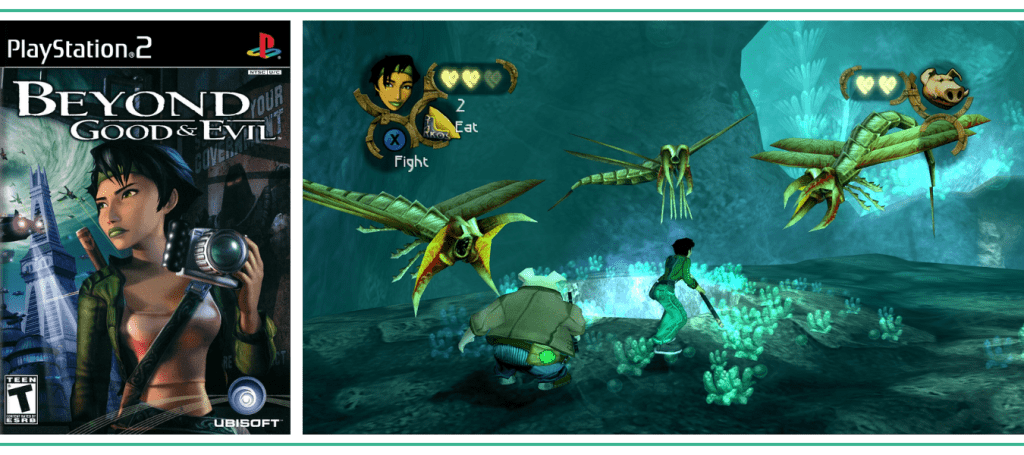
Beyond Good & Evil
Nowadays, the Beyond Good & Evil name is synonymous with dead-end trailers and unfulfilled promises. Ubisoft may have fumbled the bag big-time with the long-awaited sequel, but the only reason fans care about BGE2 at all is because the original 2003 classic exists.
Beyond Good & Evil had a lot in common with fellow PlayStation 2 games at the time. It was a third-person action adventure with a mix of combat, platforming, and stealth sequences. It had kooky anthropomorphic characters, a lot of crude humor, and plenty of charm. But what set Beyond Good & Evil apart from names like Jak & Daxter, Sly Cooper, and Ratchet & Clank was its larger-than-life scale and its badass femme protagonist.
Yes, Beyond Good & Evil was a textbook “PS2 game,” but it was also so much more. The ability to snap pictures with Jade’s camera added an interesting wrinkle to the mix, bringing out the beauty of the world while serving as a precursor to modern photo modes. The story of Jade and Pej was equal parts thrilling and devastating, keeping players hooked from start to finish. And let’s not forget those speedboat chases!
It wasn’t a perfect game then, and it isn’t a perfect game now. (Those late-game stealth sequences still frustrate me.) Yet, despite the occasional jank, Beyond Good & Evil manages to transcend its PS2 parameters, living on in the public eye as something far greater.
– Written by David Silbert
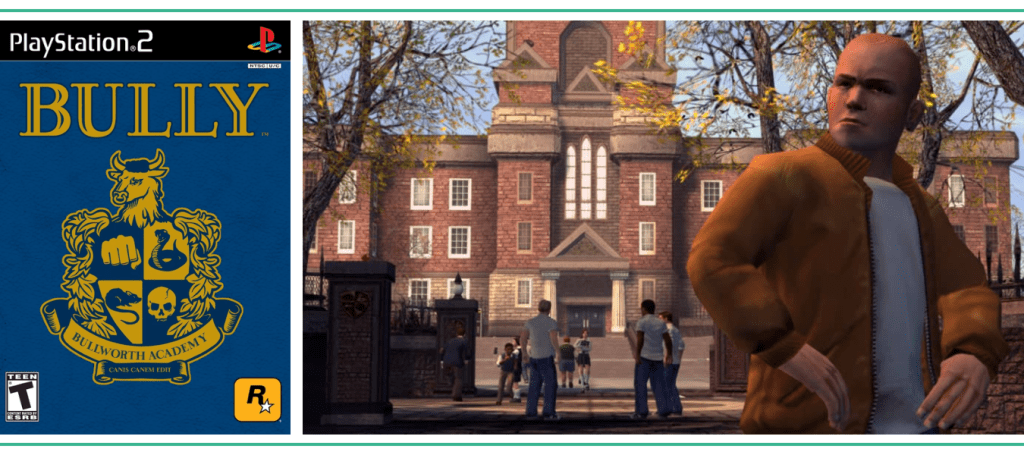
Bully
Everyone knows a bully in their life. Maybe your boss is a hardass, or the woman in the next apartment always makes unwarranted comments about your dog. Perhaps you were shoved in lockers by your high school’s starting quarterback. Or maybe—gasp!—you did the shoving.
The point is: Life is hard, and bullies make it even harder. But in Bully from Rockstar Games, you get to flip the script by becoming any bully’s worst nightmare: an even bigger bully. Sure, it’s not the greatest message on Earth, but that shouldn’t be much of a surprise coming from the studio that brought us Manhunt and Grand Theft Auto.
Jokes aside, Bully was a momentous release in 2006 for a few different reasons. Unlike previous Rockstar releases like Grand Theft Auto: San Andreas (2004), which provided players with a massive sandbox to explore, Bully sharpened its focus on a single boarding school in a single town. Like GTA, you could run around and cause mayhem, but instead of stealing cars, you would pull pranks; instead of running over citizens, you would breeze by them on your bike.
It was a refreshing departure from the constant reminder in GTA that life kinda sorta sucks. Add in some charming humor, sharp mission design, and a truancy system that puts pretty much any Harry Potter game to shame, and Bully remains one of the most innovative open worlds to ever exist. Now… where the hell is that sequel?
– Written by David Silbert
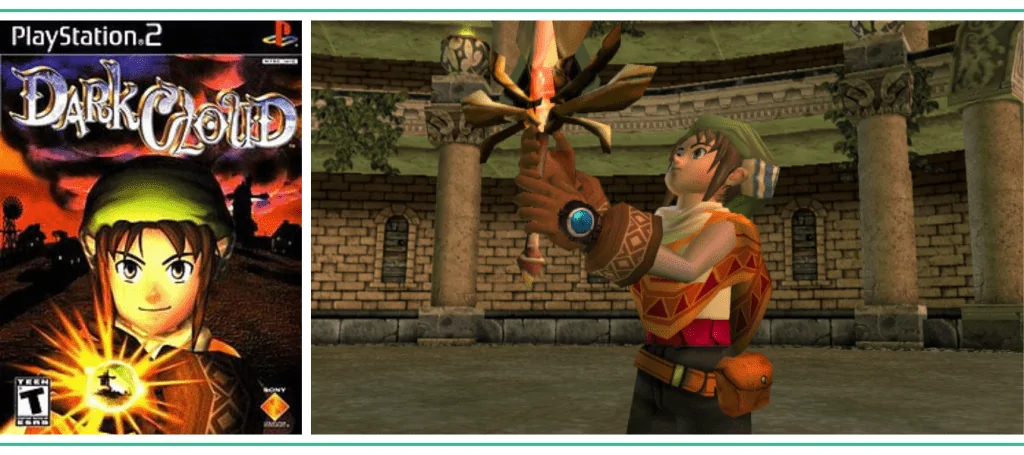
Dark Cloud
I remember being more than a little disappointed when my dad randomly came home from Best Buy with a PS2 and a copy of Dark Cloud back in late 2001. Even though I wasn’t expecting it and obviously should have been grateful, I had been a Nintendo kid up until that point and was much more interested in the brand-new GameCube than I was in the sequel to the lame-old PlayStation. Add in the fact that my dad claimed he only bought Dark Cloud because the character on the cover looked like Link, and it felt like there was some serious salt being rubbed in my wounds. Of course, the PlayStation 2 ended up being the highest-selling console of all time, and wouldn’t you know it, Dark Cloud became one of my absolute favorite games ever.
To this day, I’ve yet to experience anything quite like it. And that’s not for lack of trying, as there’s a good chance “games like dark cloud” is my most Googled phrase. What makes it so unique is a seamless blend of dungeon crawling hack ‘n’ slash combat and town building that, with those powers combined, create a gameplay loop that is just as addicting as it is fulfilling.
The story follows our green-hatted main character from the cover, Toan, as he sets off to beat baddies, restore the world, and take on the evil Dark Genie. That dang genie has magically sealed everything in the universe into big floating orbs called Atla that only Toan has the power to access. Each Atla, found by scouring dungeons, dark woods, shipwrecks, and the like, can have objects ranging all the way from your neighbor’s bedside table, to rivers and lakes, to, well, your neighbor!
As you progress through the different levels, collecting items to repopulate the world around you, it becomes critical that you talk to the townsfolk you rescue and ask them how they would like to see their home rebuilt. Getting to know the wide array of characters, recreating their villages just the way they like, and being rewarded for your efforts is an outstanding way to spend your time. Each personal request turns putting things back together into a brain-teasing puzzle that’s a blast to parse out.
I could go on about the handful of awesome allies who join your party throughout the adventure, or the unbelievably robust weapon crafting system, but I’d truly never stop. Ultimately, Dark Cloud is a classic, one of my all-time must-plays, and proof that sometimes it’s okay to judge a book (or game) by its cover.
– Written by Zack Gulinello
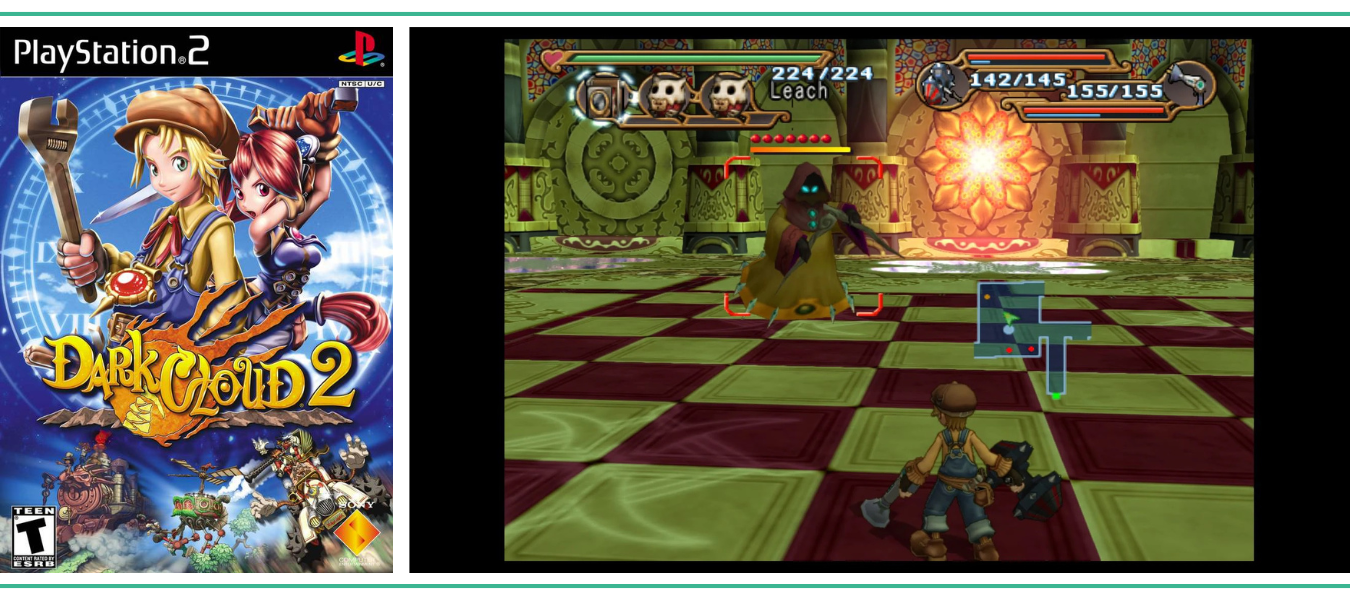
Dark Cloud 2
Dark Cloud 2 (or Dark Chronicle as it’s called overseas) tells the story of Max and Monica as they travel across time to save the world. The premise is what you would expect from an early 2000s PS2 action-adventure title, but the gameplay is what makes this title a standout. Unlike Zack, I didn’t play Dark Cloud; in fact, I convinced my dad to buy this inside a Sam’s Club based on the strength of the cover art alone. It’s become one of my favorite chance purchases of all time.
Gameplay in this fantasy, steampunk-inspired world consists of clearing a series of levels within a dungeon while meeting the occasional gameplay condition or restriction, such as “use only this weapon or character” or “beat it within X time limit.” There are guns, magic, swords, wrenches, and even a giant robot, all of which are customizable.
As you complete each dungeon, you gather resources that help you rebuild the world thanks to a giant flying machine, which helps you place materials like it’s Rollercoaster Tycoon. A clever time-travel mechanic lets you check your progress and learn what materials are needed for each area. Photography also plays a critical role, as Max takes inspiration from each picture you capture to create new items for the characters on your journey.
Throw in clever mini-games and a rich cast of characters, and you have one of the most charming and challenging titles of its time, and one of my all-time favorites.
– Written by Vaughn Hunt
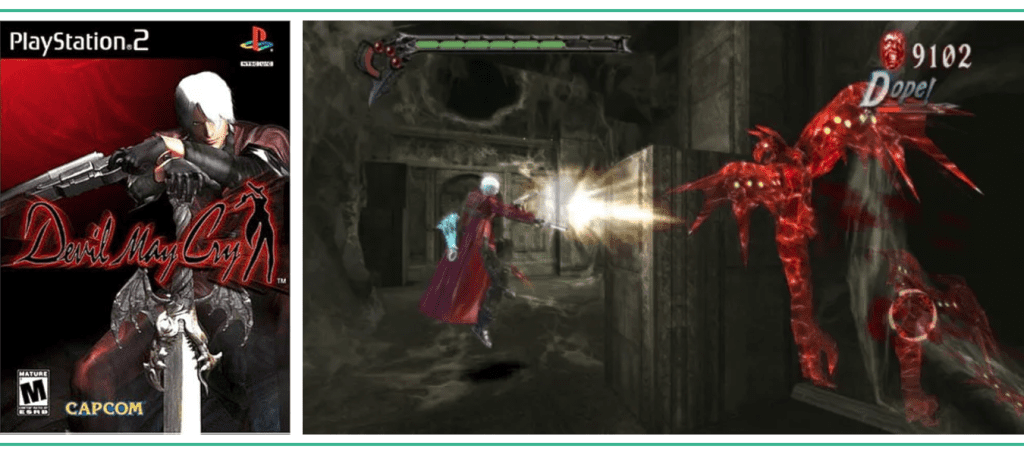
Devil May Cry
Devil May Cry 3 might be the popular choice to include on a list of the best PlayStation 2 games, but the original Devil May Cry is the entry that started it all.
There’s so much to like about Devil May Cry, from its buttery-smooth combat to its batshit-crazy cutscenes. Dante’s indifference in the face of overwhelming odds is more motivational than a rousing TED Talk, and Ebony and Ivory are easily the greatest gaming pistols short of Halo: Combat Evolved’s magnum.
The series may have grown stronger over time—Devil May Cry V, for my money, is the greatest action game ever—but it’s hard to overstate how consequential this game was not just for the PlayStation 2, but video games as a whole. Decades later, we’ve seen new playable characters, an anime, and even a shitty Devil May Cry mobile game, but the core “slide, dice, shoot ‘em up” gameplay hasn’t missed a beat.
It’s rare to see a franchise with so much history, yet so much promise still on the horizon. Devil May Cry set the tone back in 2001, and it’s still taking names to this day.
– Written by David Silbert
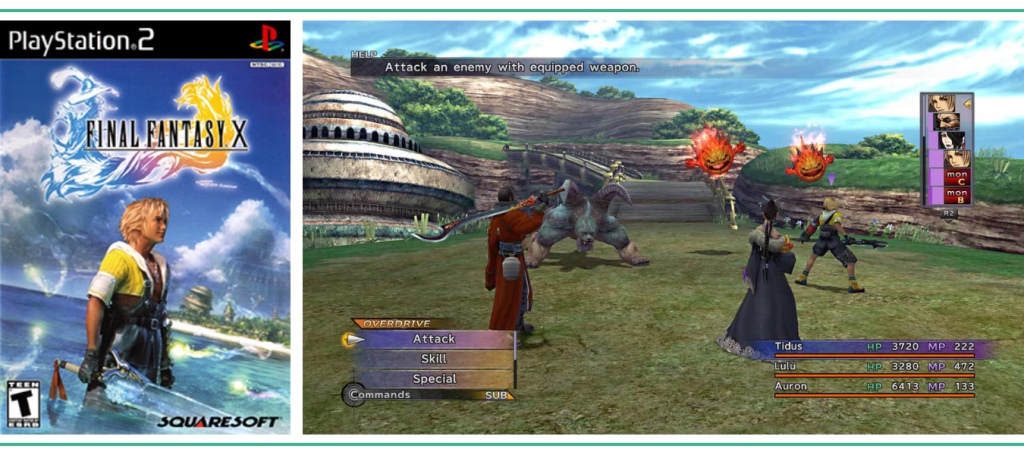
Final Fantasy X
Modern Final Fantasy games get a lot of flak for straying too far from their roots. Amid common complaints (“It’s not turn-based! Where are the summons?! No party members???”) is the prevailing sentiment that Final Fantasy simply isn’t as good as it once was.
Though I don’t necessarily agree with the take, if you find yourself in that old-school camp, I understand why you feel the way that you do. Older Final Fantasy games are awesome, and it’s a shame we don’t see a commitment to slower, more methodical takes on medieval fantasy.
Case in point: 2001’s Final Fantasy X. Arguably the last of the Final Fantasy old guard, X walks the line beautifully between PlayStation classics like VII and more modern games like XIII. Like the PlayStation 1 games before it, X features turn-based combat, powerful summons, silly humor, mini-games, sublime music, and a lovable cast of party members. At the same time, its tender voice work and gorgeous 3D visuals ushered in a new generation of Final Fantasy.
Make fun of laughing Tidus all you want. When it came to epic storytelling, engaging battles, and emotional stakes, Final Fantasy X was the series at its absolute best.
– Written by David Silbert
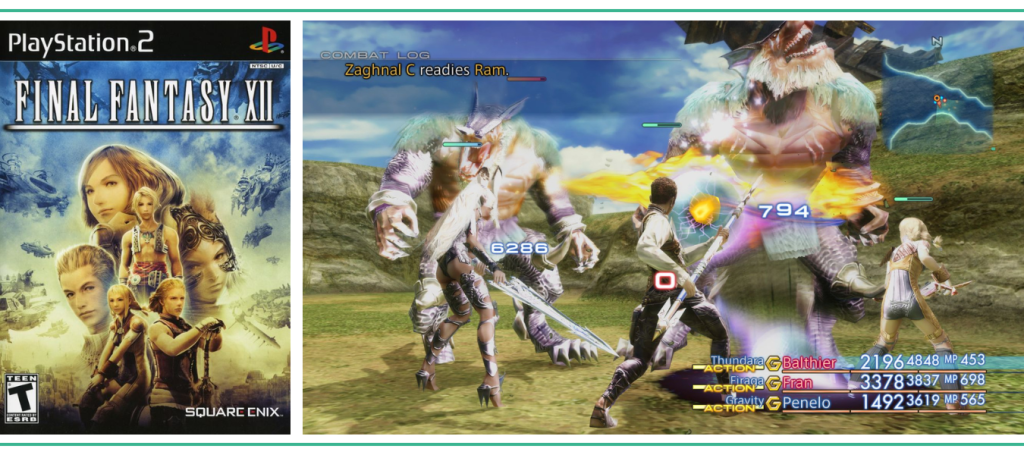
Final Fantasy XII
If Final Fantasy X marked the end of the turn-based era, then Final Fantasy XII was the franchise firmly embracing its new future. Gone were random encounters; instead, monsters roamed a series of open zones. As you engaged with these foes, you’d enter commands for your party members, then watch as they carried out your orders in real time. Adding several extra layers was the Gambit system, which allowed you to design careful if-then logic for each of your characters, then execute those Gambits like a carefully crafted computer program.
In many respects, Final Fantasy XII was the natural evolution of turn-based combat. You still gave the commands—they were just broader and more strategic in scope, not too dissimilar to a real-time strategy game. However, the mechanics proved controversial for many, and Final Fantasy XII as a whole received its fair share of criticism. Some maligned the story; others lamented the ensemble cast and weak protagonist, Vaan.
Take a step back, however, and it’s easy to appreciate Final Fantasy XII for what it achieved. No, it didn’t please everyone, and we all know Balthier was the real leading man. But XII was the first in the series to embrace a darker, more mature tone—long before the likes of Clive Rosfield. Its plot was layered, its cast was compelling, and its voice acting was second to none. Like a bottle of twenty-year Bordeaux, Final Fantasy XII has aged with grace.
– Written by David Silbert
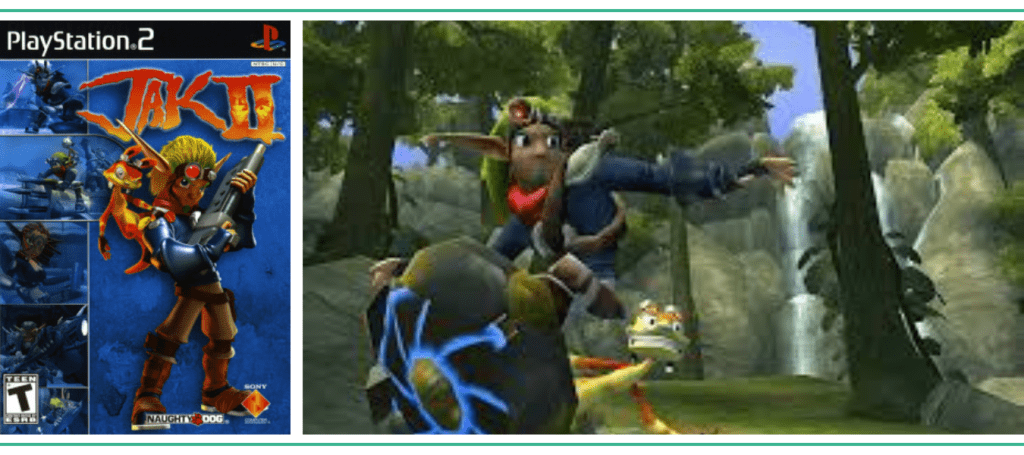
Jak II
Naughty Dog’s Jak II was magical. One part platformer like its predecessor, and one part Grand Theft Auto clone, the game was the “serious” sequel to Jak and Daxter: The Precursor Legacy, introducing vehicles, a dystopian storyline, and Dark Jak. Years before my parents would let me play GTA at home, I was causing mayhem with zoomers (hover-bikes) and the game’s morph gun across Haven City.
My fondest memory of Jak II is playing it with my cousin on a rare cold February day in Texas. Due to various life circumstances, this was the first time we had met in person, and as two boys growing up in the aughts, our bonding focused mostly on which video games we were currently playing. Jak II was new to my library; it consumed my imagination and every conversation. It didn’t take much to convince my cousin to play a few platforming segments and explore a little of the dystopian city.
Jak II transitioned Naughty Dog from platformers to games as narrative vehicles. My cousin and I still bond over the studio’s latest games, playing the Uncharted games throughout our college years, The Last of Us and its sequel, and, more recently, speculating about what might be next.
– Written by Clint Morrison, Jr.
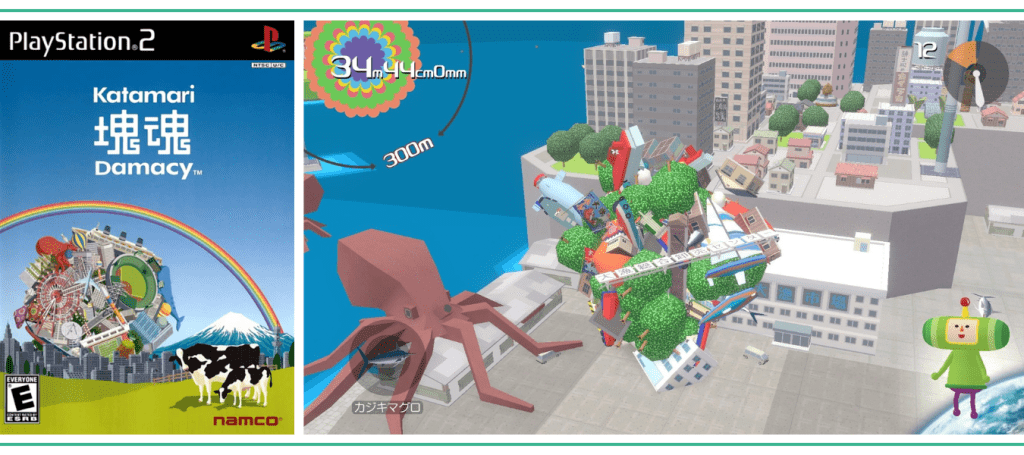
Katamari Damacy
Something that often gets forgotten when discussing the PS2 generation is that even though some of the most notable experiences were highly cinematic and story-focused, the console still made plenty of space for quirkier titles. Few games of that era represented “quirky” quite like Namco’s 2004 puzzle-action game Katamari Damacy.
The premise is simple, yet brilliant: You play a small, green person (the prince) who is tasked with creating new stars for the King of All Cosmos. How do you make stars, you may ask? Well, of course, you roll a magical, highly adhesive orb over tons of objects and living beings of varying sizes until that ball is big enough to be a star. Some levels ask the player to roll over small things in a small environment—pennies, paperclips, dominoes—while later levels have you rolling over large boats and even entire islands.
Katamari Damacy is a fairly bizarre and basic idea, yet it’s executed to perfection. Every level presents the same types of challenges, yet they feel distinct each time. I have to keep increasing the size of the ball in order to roll over even larger objects, and once I roll over those objects I can access new areas and even LARGER objects (and, yes, human beings sometimes). It’s an addictive feedback loop, one that never fails to keep me engaged.
I’m not sure there’s really much else I can say about the game (besides it’s joyful, ebullient soundtrack and blocky, almost Lego-like art direction). In essence, it’s just plain fun, and even decades later remains one of the more creative and kooky ideas any major game publisher has attempted.
– Written by Sam Martinelli
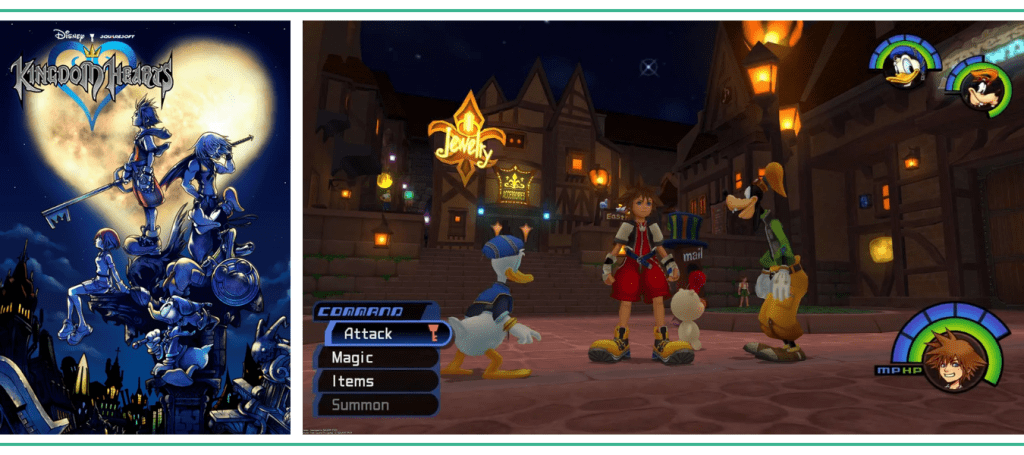
Kingdom Hearts
You can’t have a list of the greatest PlayStation 2 games without mentioning Square Enix’s Kingdom Hearts franchise. Initially conceived as a Final Fantasy spin-off franchise, Kingdom Hearts has grown to become so much more than its origin story.
It’s hard to believe it’s been over 20 years since players were first introduced to Sora, Riku, Kairi, and their unforgettable universe. The list of Kingdom Hearts’ charms runs long: the mesmerizing tides of Destiny Islands; the “so weird, it works” mashup of Disney and Final Fantasy characters; the melancholic sounds of “Dearly Beloved”; and, of course, those zippers.
The series would see some crucial innovations over the coming years. Kingdom Hearts: Chain of Memories introduced Organization XIII and set the precedent for handheld-only spin-offs with confounding titles. Kingdom Hearts II introduced the “Reaction Command,” which allowed players to perform contextual dodges or attacks based on the specific enemy or battle. And Kingdom Hearts III… Well, the less we say there, the better.
But the original Kingdom Hearts was where it all started. Its camera might not control the greatest, and other entries have greater highs, but this is as close to PS2 royalty as it gets.
– Written by David Silbert
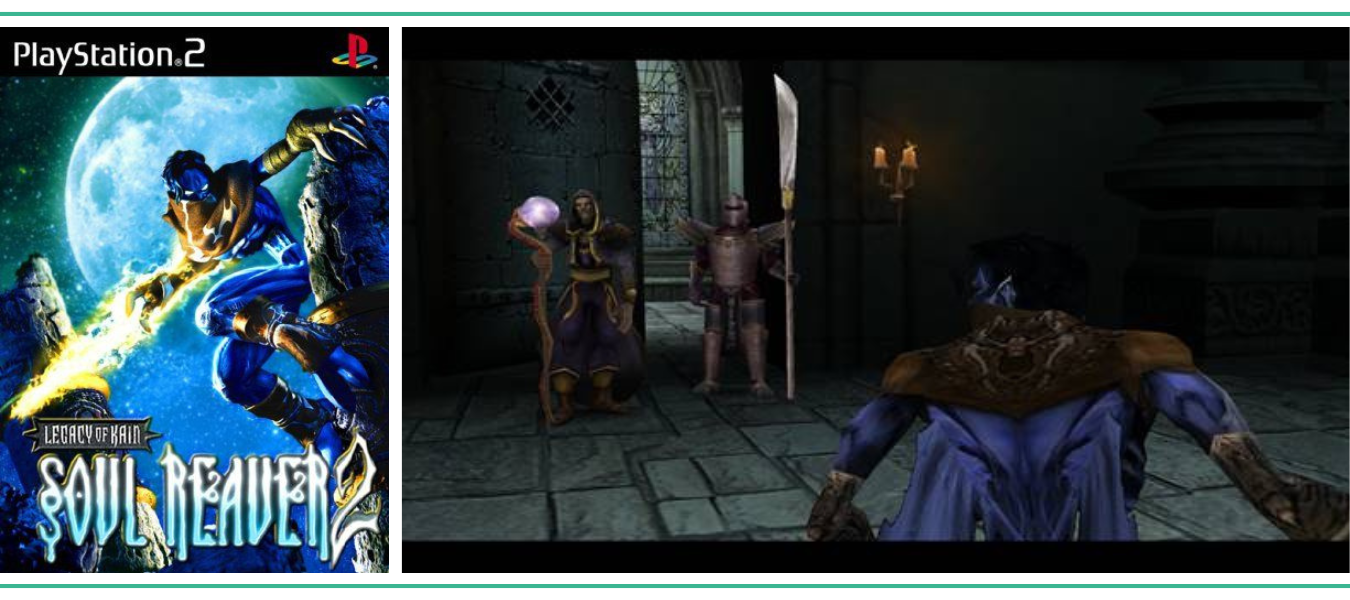
Legacy of Kain: Soul Reaver 2
There is no thrill like having something you’re not supposed to have when you’re a kid. The secret chocolate bar, the R-rated DVD you bartered for on the playground, the channel only you know about that shows fuzzy WWE PPV’s (maybe that last one is just me): We all want our little treasures.
I was both the oldest and youngest of my family growing up. In my house, I was the oldest brother to my direct sibling. But, I was also raised with three cousins and two neighbors. Jimmy, Kimmy, and Kerry were all five years older than myself, Ray (Kimmy’s brother), and Erin (Kerry’s sister). So, on one hand, I had all the responsibility of being an older sibling to my brother. On the other hand, I was still one of the youngest, striving for attention and recognition from my older cousins.
So, I did what any good American boy does in this situation: I stole the coolest looking game I could from Jimmy. In this case, Soul Reaver 2. Had I played any of the other Legacy of Kane games before it? God, no! Was I lost the moment I popped the disc into my PS2? Absolutely! But at the same time, I was engrossed in the sweeping narrative. Vampires and ghosts and vampire ghosts, shifting planes to solve puzzles, time travel shenanigans: It all blew my mind as a child. I fell in love with the tragedy of Raziel and his pursuit of vengeance, even if the hack-and-slash gameplay was fairly simplistic. I devoured Soul Reaver 2 like Raziel devours souls, getting as far as I could.
Imagine my shock, then, when I presented the copy back to Jimmy to say I beat it, only for him to say he never played it. The tragedies of trying to be cool, I suppose.
– Written by Gary Wilson
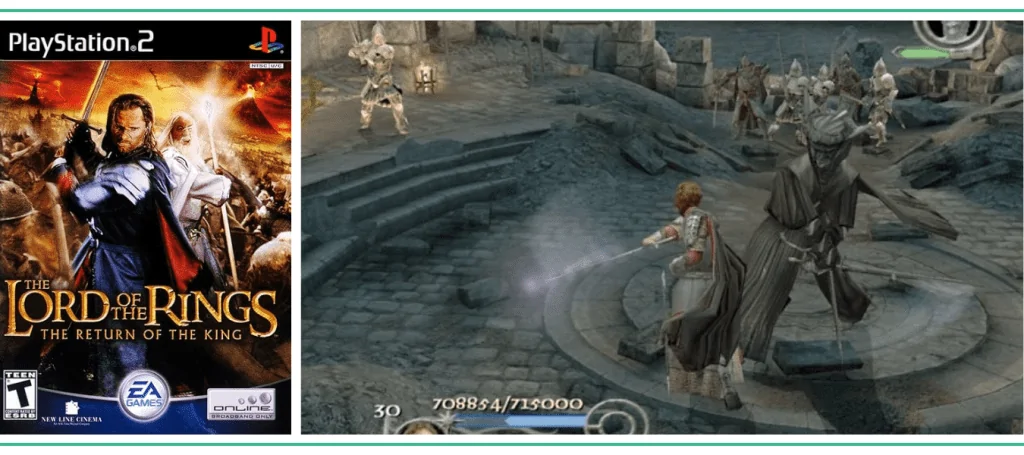
The Lord of the Rings: The Return of the King
As you’ll come to find out with my other entries on this list, the PlayStation 2 era also coincided with my peak movie franchise fandom. Unfortunately, that means I played a lot of half-baked video game adaptations of my favorite movies. But there was one game to rule them all in The Return of the King.
It’s honestly hard to talk about this game without mentioning The Two Towers, but where its predecessor focused on only Aragorn, Legolas, and Gimli’s adventures, The Return of the King lets you play as the entire Fellowship (well, almost the entire Fellowship. Sorry, Boromir. At least you get the chance to help Faramir to show his quality). There is an insane amount of care put into making each main character feel distinct, and the co-op feature allows you to easily compete with friends for most kills in a level. I’ve spent countless hours with each character at “The Southern Gate” taking on the seemingly endless hordes of orcs just to claim that I maxed out my kill count.
One of my favorite things about this game, though, is that it was made at the same time as the movie, meaning the development team didn’t have all the final details. Because of this, a lot of original cutscenes or concept designs are used in the game, making it stand just a little more on its own. It was only fair that one of the greatest movies of all time got one of the greatest video game adaptations of all time, and it still sticks with me to this day.
– Written by Mark Bowers
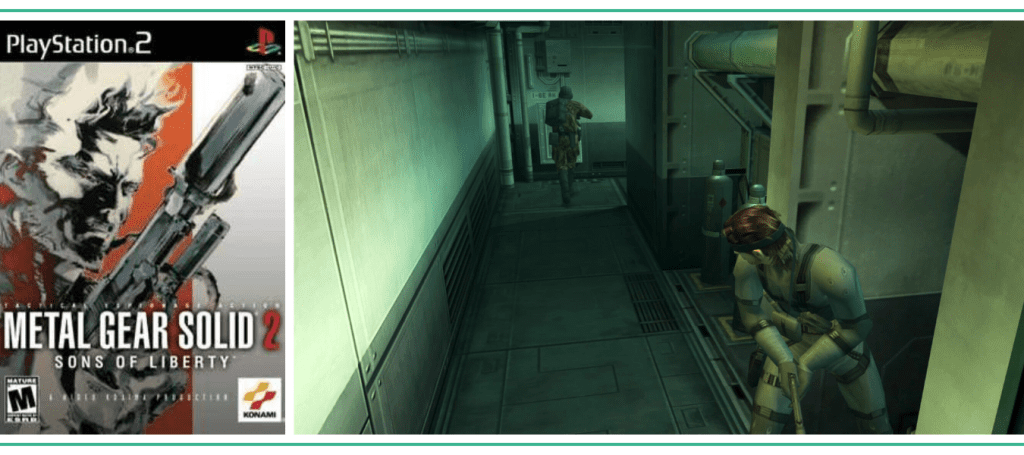
Metal Gear Solid 2: Sons of Liberty
Metal Gear Solid 2 was my introduction to postmodernism. This probably isn’t wholly true, but I was a little too young to actually play Hideo Kojima’s masterpiece when it came out and was still too young when I had the chance to play it.
I’ve written before about not really knowing better about the protagonist fake-out, transitioning from the legendary hero Solid Snake on the Tanker to Raiden on the Big Shell. While sacrilegious, I remember not being terribly thrilled about the game’s opening Tanker mission with Snake; frankly, I didn’t really know who this Snake fellow was outside of a little time with Metal Gear Solid: Twin Snakes and a Metal Gear Solid 4 trailer.
I felt a wave of relief when Raiden seemed to know as little about the world of espionage that he had stepped into as I did. My knowledge was built on advertisements and Game Informer articles, and Raiden’s understanding was built by VR training. We both had incomplete versions of stories that had been deconstructed, close read, and reframed for us. It was a spy story re-envisioned and made palatable for a different audience than the one playing the first Metal Gear Solid. The game plays with this discomfort of the familiar as the player sneaks around Big Shell, its elements uncannily reimagined like living in someone else’s video game.
Rediscovering the game alongside Raiden was dizzying at first, especially at a young age. It felt like unlearning what came before. Unknowingly, Metal Gear Solid 2 created a palimpsest—erasing what existed once for something new. I didn’t fully comprehend what Raiden and I were unlearning at the time, but it created a fresh canvas I still look back fondly on.
– Written by Clint Morrison, Jr.
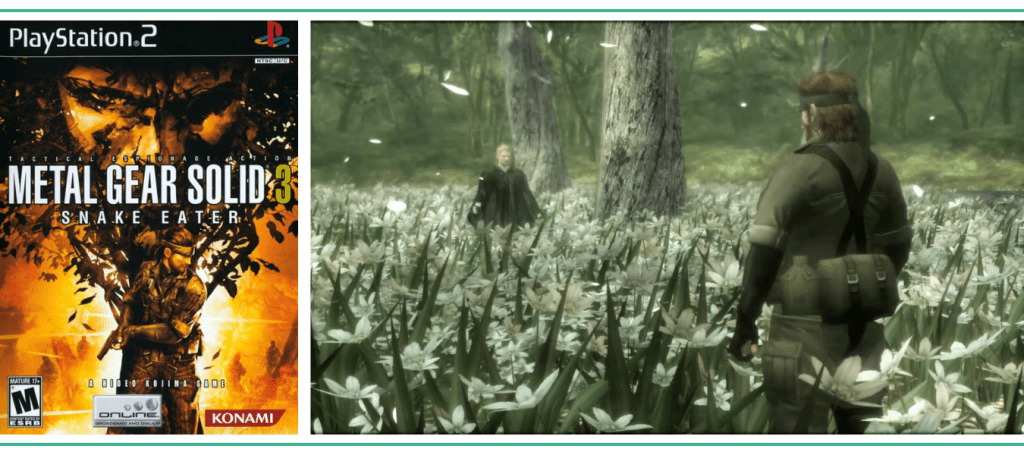
Metal Gear Solid 3: Snake Eater
It’s impossible to write, let alone think about Metal Gear Solid 3 without its titular song playing in your head. The third game in Hideo Kojima’s series is considered by many to be the magnum opus. A prequel, and chronologically the first game in the larger Metal Gear universe, it offers our first glimpse into the man who would become “Big Boss.”
Snake Eater opens with Naked Snake completing the world’s first HALO (high altitude, low opening) jump as part of his “Virtuous Mission.” He finds himself alone in enemy territory, in this case a Soviet Union jungle, and is being guided by an iconic support cast of characters via radio. What starts off as a covert rescue mission quickly becomes chaotic, leading Naked Snake into a larger Cold War affair. Amid betrayal and an international crisis, Snake finds himself on a mission spanning global politics, advanced technology, and deep-state espionage.
MGS3 has one of the most intricate control schemes we’ve seen in gaming with the introduction of its CQC or “close quarters combat” system. The angle of the joystick and even the pressure of the action buttons determine the severity of an action. Snake hunts throughout the game by catching snakes, frogs, birds, and whatever else he can get his knife through to maintain his stamina. The game also maintains a body damage data system, tracking every injury and encouraging players to perform necessary medical procedures or face health- or stamina-damaging consequences. Particularly novel, players could rely on a “camo index” to see the level of visibility in their current environment and change camos to match their terrain.
With an incredible score, unique boss battles, and a story that is James Bond meets Rambo, Snake Eater is the definitive spy experience. All that to say, climbing ladders will never be the same.
– Written by Vaughn Hunt
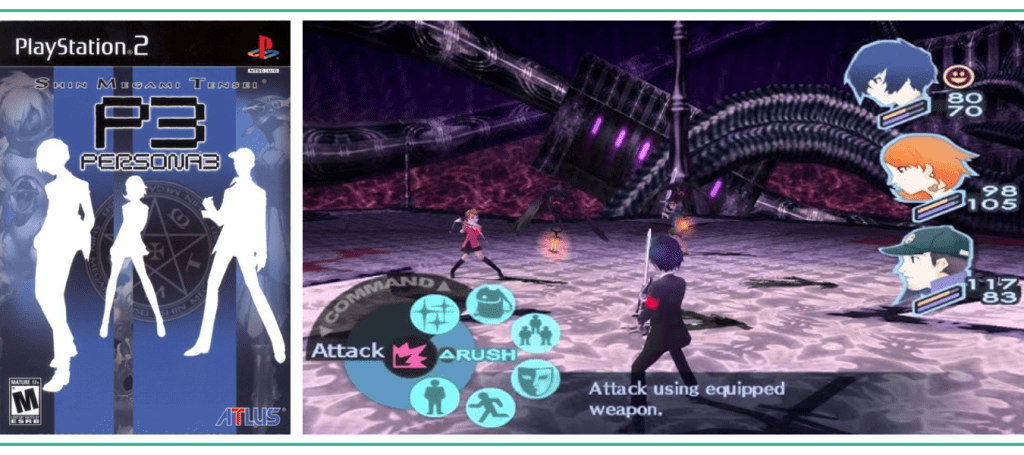
Persona 3
The Persona franchise has exploded in popularity over the years. What once was a niche spin-off of the already niche Shin Megami Tensei franchise has become the last bastion for quality turn-based RPGs.
Odds are, if you’ve played a single Persona game, it’s Persona 5. It makes sense: Joker and the Phantom Thieves’ adventure was the most accessible to date, and if there ever was a perfect starting point for the franchise, it’s P5. Yet, there’s a wealth of amazing legacy Persona games to dig into, provided you’ve got the patience and the time.
Look no further than Persona 3, a 2006 PlayStation 2 release that brought the series into the modern age. Gone was the first-person dungeon-crawling of Persona 1 and 2, replaced with an explorable 3D world filled with interesting characters and thoughtful stories. Much like how Final Fantasy X bridged the gap between old-school and new-school Final Fantasy, Persona 3 paid respect to its SMT roots while paving the way for the franchise of today.
That’s not to say it hasn’t shown its age. Tartarus—the main source of questing in P3—can be a slog, especially compared to the carefully crafted palaces of P5. The graphics and music are also fairly dated—though, thankfully, a recent remake, Persona 3 Reload, successfully smoothed out the rougher edges.
At its core, though, Persona 3 is about the story. And boy, does it deliver. Excellent characters, brought to life with stellar voice acting; nuanced writing that deftly weaves between levity, despair, hope, longing, and love; social links that touch upon everything from illness to depression; an ending that’ll make you think, then cry, then think again… Persona 3 has it all.
– Written by David Silbert
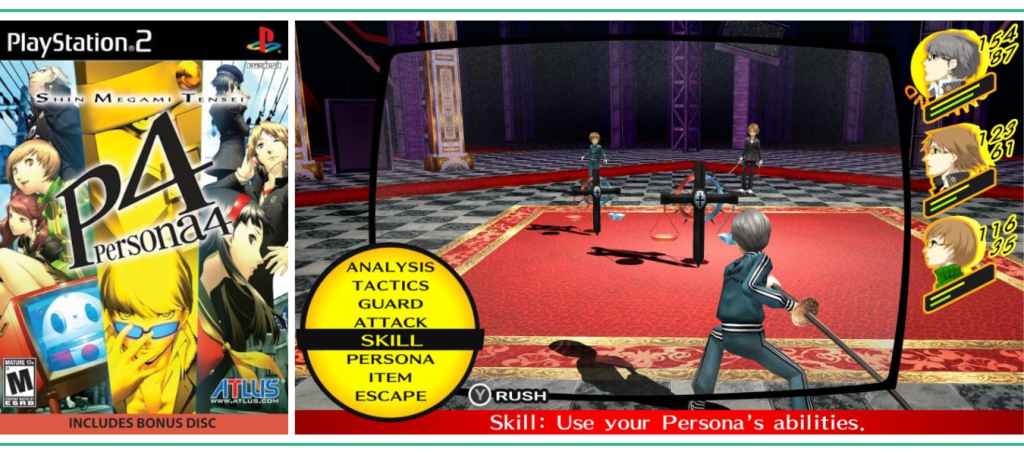
Persona 4
Much has been written already about how the Persona series shaped modern games. Everything from Fire Emblem to Marvel’s Midnight Suns has taken pieces of what has made Persona so popular: the connections between characters, the quiet moments, the investment in personal dynamics. As for me, 2008’s Persona 4 changed my relationship with games, and what I want out of them.
While I had always enjoyed RPGs growing up (check out my Kingdom Hearts entry on our most hyped video games list for more details), it really wasn’t until Persona 4 that I realized I craved compelling stories in games. Sure, there were games like Portal or Modern Warfare that had stories, but they lacked character. Persona 4 hit that sweet spot for me in a way that, really, nothing has since. The love and care within the Investigation Team drives the story, and having each character accept themselves and grow was stunning. I still tear up a little thinking of Naoto Shirogane, who only ever craved being accepted as both a genius and a woman, accepting that the world may be judgemental of her but that it doesn’t mean she can’t be great.
For a young person back then trying to figure out my place in the world, seeing these teens accept and learn to love themselves was deeply affecting. Even today, at least 14 years since I first played it, I still count Persona 4 among my favorite games of all time, and one I recommend to anyone.
– Written by Gary Wilson
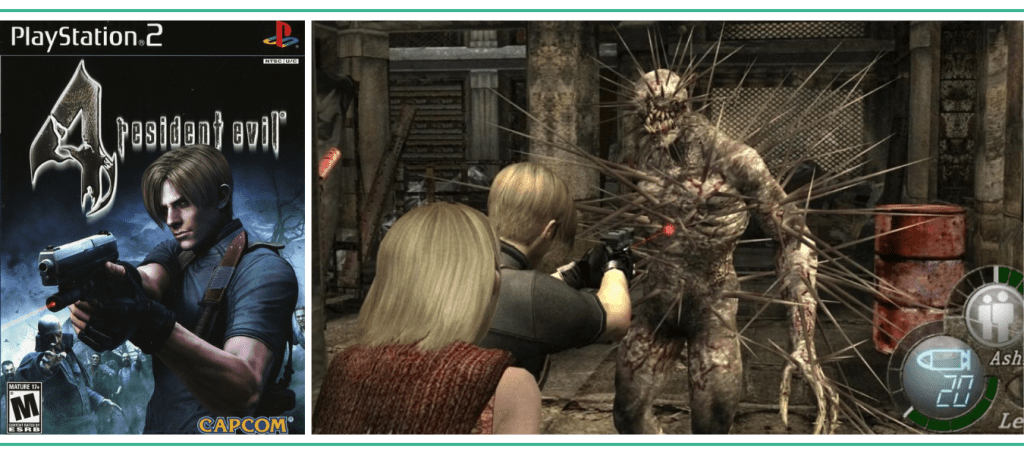
Resident Evil 4
Okay, I’m cheating a little bit here. Capcom’s 2005 masterpiece Resident Evil 4 originally launched as a GameCube exclusive, and that’s how I first played it (and, to this day, it remains my favorite way to play the game). However, watching several of my friends play the game-changing survival horror title on their PlayStation 2 consoles ultimately convinced me to buy the game myself.
If you’re unfamiliar with the greatness that is RE4 (how unfortunate), here’s the quick rundown: Police officer Leon Kennedy is tasked by the President of the United States to travel to a rural part of Spain to rescue the president’s daughter from freakish, zombified cultists.
While the story itself isn’t particularly special (though the hilarious B-movie writing is spectacular), Resident Evil 4’s gameplay systems set new standards for the medium and pioneered certain mechanics that would immediately become commonplace. For example, RE4 was one of the first games to master over-the-shoulder shooting mechanics in a third-person shooter, and forced the player to hold an aim button before they could open fire. Just as important, however, was the game’s emphasis on creativity within combat, where the player can experiment with alternating between their knife and guns or attacking different parts of enemies’ bodies for different results.
This blurb doesn’t contain enough space to explain just how important and incredible Resident Evil 4 was when it first came out. But what makes it one of the best games of all time (and, obviously, one of the best PlayStation 2 games ever) is that it remains a delight to play, even to this day. Sure, the 2023 reimagining is a phenomenal experience as well, but the original is still more than worth checking out.
– Written by Sam Martinelli
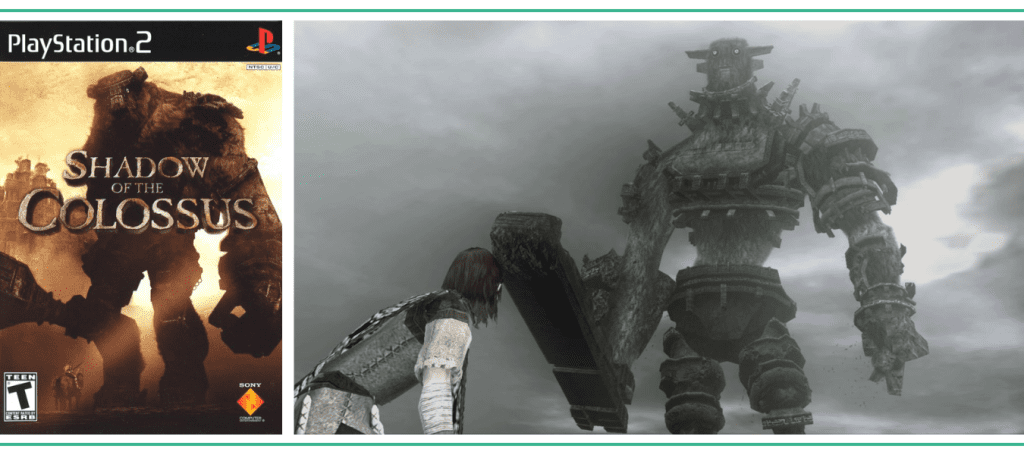
Shadow of the Colossus
This isn’t the first time I’ve been given the opportunity to wax poetic about this game, and honestly, it probably won’t be the last. Developed by Japan Studio and Team Ico and released in 2005, Shadow of the Colossus is often lauded as a groundbreaking and thoughtful title. (It even features in Reign Over Me, an Adam Sandler film about… 9/11 and PTSD. This makes me sound like I’m making fun of the movie, but it’s actually decent.)
Shadow of the Colossus is a dichotomous experience that deftly pairs tense, controller-gripping boss-rush gameplay with melancholy, ponderous exploration in a gorgeously crafted but lonely landscape. Combine that with Kow Otani’s incredible score and a sparse yet evocative narrative that leaves players theorizing, to this day, about the details of its story and characters, and you’ve got a banger on your hands.
I didn’t play Shadow of the Colossus at release. It was actually one of the last games I played on my PlayStation 2 before I got my PlayStation 3 (a console I ordered from Japan so I could play Final Fantasy XIII early… a story for a different time). I’m glad that I didn’t play it at release—truthfully, I don’t think it would have stuck with me in the same way if I had played it at 10 years of age.
It’s not a flawless game, by any means. The framerate can be… difficult at times, the camera is a challenge unto itself, and the controls for moving on horseback perhaps leaned a tad too far in the “emulating the realism of controlling such a majestic beast” aspect. Most of the colossi (the titular enemies of this boss rush game) are wonderful encounters; a handful are clunkers. Still, Shadow of the Colossus is a singularly unique experience, simultaneously exhilarating and melancholic, intense yet solitary, and I’ll recommend it to anyone. (I’ll even settle for the PlayStation 4 remake by Bluepoint Studios, though I have thoughts on it, as many fans of the original are wont to have.)
– Written by Kei Isobe
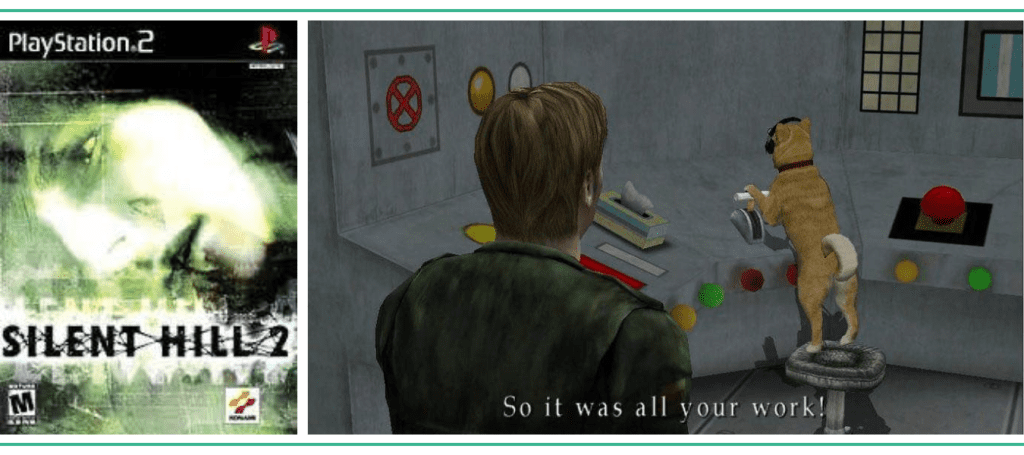
Silent Hill 2
Five excellent third-person Silent Hill games graced the PlayStation 2. Yet Silent Hill 2 is the one title that lives in our collective memories, from its opening moments when James Sunderland looks into the mirror of a public restroom on the town’s outskirts to the bonus “Dog” ending. This entry is also where Team Silent introduced its most recognizable monster, Pyramid Head, in a moment that I am delighted to say is still utterly terrifying. The game is psychologically haunting, with a story of man searching for his wife that still holds up 23 years later.
In preparation for 2024’s remake, I recently revisited Silent Hill 2 for the first time in over a decade. It felt like visiting an old acquaintance for afternoon coffee who you’ve heard rumors about but whose internet presence is obscure at best.
I wasn’t sure that our conversation would live up to those teenage memories altered with time. Yet, as I navigated the foggy streets of Silent Hill and dark apartment spaces, I found joy in the familiarity and fright. Years later, no other game has quite captured the feeling of that town.
I’m hopeful that this narrative will find new players on October 8, with Bloober Team’s remake.
– Written by Clint Morrison, Jr.
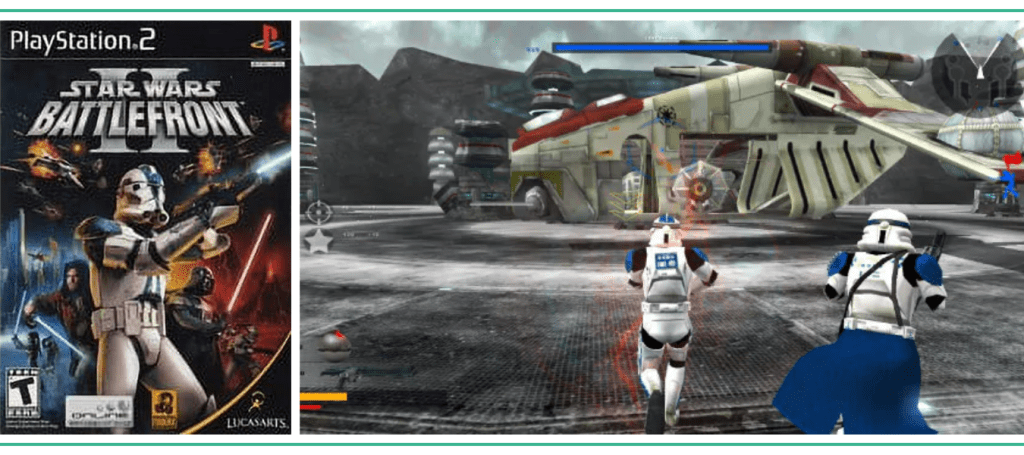
Star Wars: Battlefront II
Battlefront II was one of the most important games of my childhood. The game launched right at the peak of my Star Wars fandom, so getting to play huge battles on all the planets I’d come to know as my favorite heroes (and villains!) was a dream come true for me. Not to mention it was the first T-rated game I was ever allowed to play.
I could go on for hours about how much I loved this game. I knew the ins and outs of all the maps, which ones were great (Tantive IV) and which ones weren’t worth playing (cough cough Kashyyyk), and once I figured out how to up the reinforcement count by 500%… there was nothing stopping me from a great time. Throw in the extra game modes like Hunt and Galactic Conquest, and I was getting something new thrown at me at every corner.
It truly felt like I was immersed in a galaxy far, far away, and even now, nearly 20 years later, I am still finding it hard to put down. I know, I know… Aspyr’s recent port has its own problems. But I can’t be too mad when it made me feel like I was back in middle school fighting for the fate of the galaxy all over again.

Star Wars: Super Bombad Racing
That’s right—another Star Wars game! Where Battlefront was everything gritty about Star Wars, Super Bombad Racing was everything goofy about it. Whoever came up with the idea of Mario Kart in Star Wars deserves a raise (if they’re still there—it’s been 20+ years). Pair that with the caricatures of some of The Phantom Menace’s most iconic (and silliest) characters, and you’ve got a racing game for the ages!
I have fond memories playing this game with my brothers and taking them down with Jar Jar’s tongue or Boss Nass’s spit (yes, these are real abilities in the game), and the wonky musical theme still lives in my head to this day. It’s far from the greatest racing game of all time, but those wacky giant heads sitting in the tiny starships made for some great play when I was growing up. Unfortunately, it never got a sequel… but who’s to say we can’t have one today?
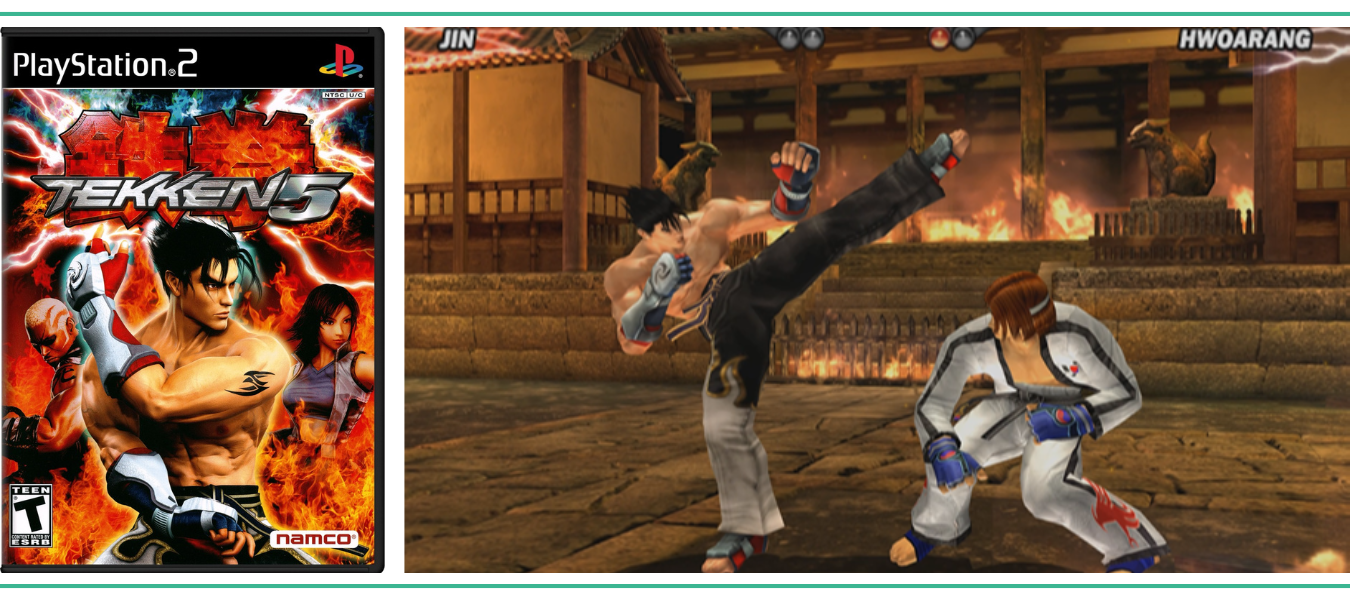
Tekken 5
Arguably the greatest fighting game of its generation (next to Soul Calibur III), Tekken 5 is the game that cemented the series’ legacy. It’s the first game in the series with multiple console releases, starting with the PS2, then later the PSP and PS3 with Tekken 5: Dark Resurrection. Moreover, the series received its first significant online competitive play with Dark Resurrection, including a ranking system (online and offline) and featured arcade versions of Tekken, Tekken 2, Tekken 3, and the unlockable Starblade (which was also the loading screen).
Set two months after Tekken 4, the fifth Iron Fist Tournament focuses on the journey of Jin Kazama as he is forced to confront his devil genes. This title marked the first entry of characters including Asuka Kazama (Jun’s replacement), Devil Jin, Feng Wei, Jack-5, Jinpachi Mishima, Raven, and Roger Jr.
With that said, Tekken 5 shifted back to the traditional gameplay familiar to Tekken 3 and Tekken Tag Tournament. The majority of the character move-sets from those games are back in updated forms. For example, Jin’s new style of karate from Tekken 4 is combined with his Mishima style, making him slightly faster, while newcomer Asuka brings a more defensive interpretation of the Kazama style. Meanwhile, Jinpachi is the most difficult final boss of the series between his teleport dodge and warp-speed fireball.
Likewise, the free-for-all Double Dragon-style “Tekken Force” is updated to the “Devil Within” game mode, focusing on Jin discovering his devil powers and escaping an underground lab. Lastly, expansive customization, including the elaborate color swap palette from Tekken 4, returned, while weapon accessories made their debut.
It’s been 20 years since its release, but Tekken 5 remains the most important game in the series after Tekken 3, growing the audience and returning the series to greatness.
– Written by Vaughn Hunt
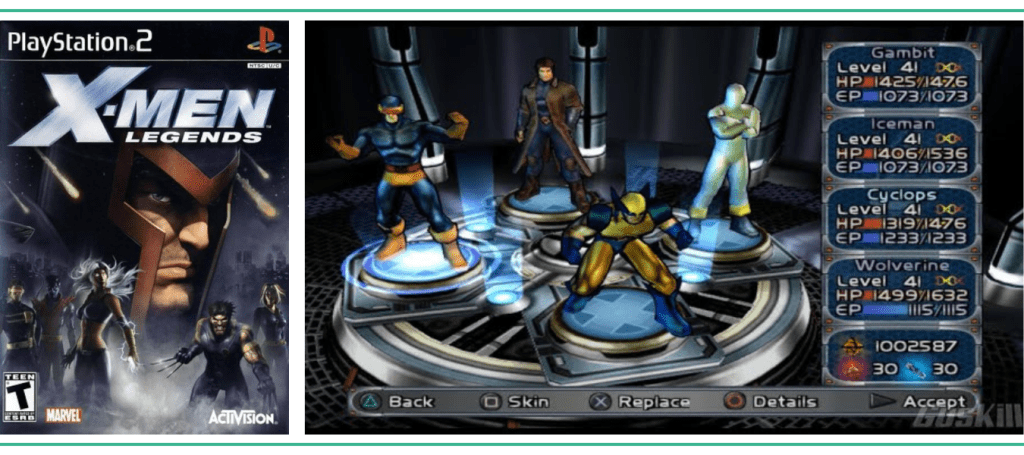
X-Men Legends
I love a good couch co-op game, and one of the first I fell in love with was X-Men Legends, a top-down fighter adventure game developed by Raven Software and published by Activision. X-Men Legends perfectly captured the feeling that the X-Men are a large collective of cool fighters with varied powers. While you start off with just a few characters, you unlock more at a rapid clip.
For most of the game, there are four characters on the squad at any given time, and you can change up your characters at regular intervals. You could also switch between the characters at any time, helpful in case the AI was doing a bad job or your preferred character had accidentally gotten knocked out. The diversity of characters gave us so much choice and autonomy and made us feel like we were really good at it. The missions were well-paced through an engaging storyline, though it was somewhat difficult—my sister and I got stuck on one time-boxed escape quest and never finished the game.
Still, X-Men Legends invited hours of fun for us. We loved watching X-Men: The Animated Series growing up (and yes, we’re very excited about X-Men ‘97), and the game brought us together. Wolverine had an overly dramatic loading screen, and we took turns making fun of his grimace. When I got new glasses, we pretended I was Cyclops. My sister would surprise me with a fan and a tornado, a la Storm!
X-Men Legends has inspired many spin-offs over the years, notably the Marvel Ultimate Alliance series. Even now, seeing those colored circles highlighting a superhero… it makes me want to lock in and return to save the world.
– Written by Amanda Tien
More Platform and Genre Recommendations
Want more content like our best PlayStation 2 games piece? Explore these other Punished Favorites lists:
- The 50 Best Video Games of All Time
- 16 of the Best Nintendo DS Games
- 10 of the Best SNES Games
- The Best Metroidvania Games To Play While You Wait for Silksong
- An Objective List of the Best Roguelike Games
- The Best Cozy Video Games
What Are Your Top PlayStation 2 Games?
Shout out your favorite PS2 titles in the comments below!
(Apr 22, 2025: Added Beyond Good & Evil, Bully, Devil May Cry, and Kingdom Hearts to the list.)


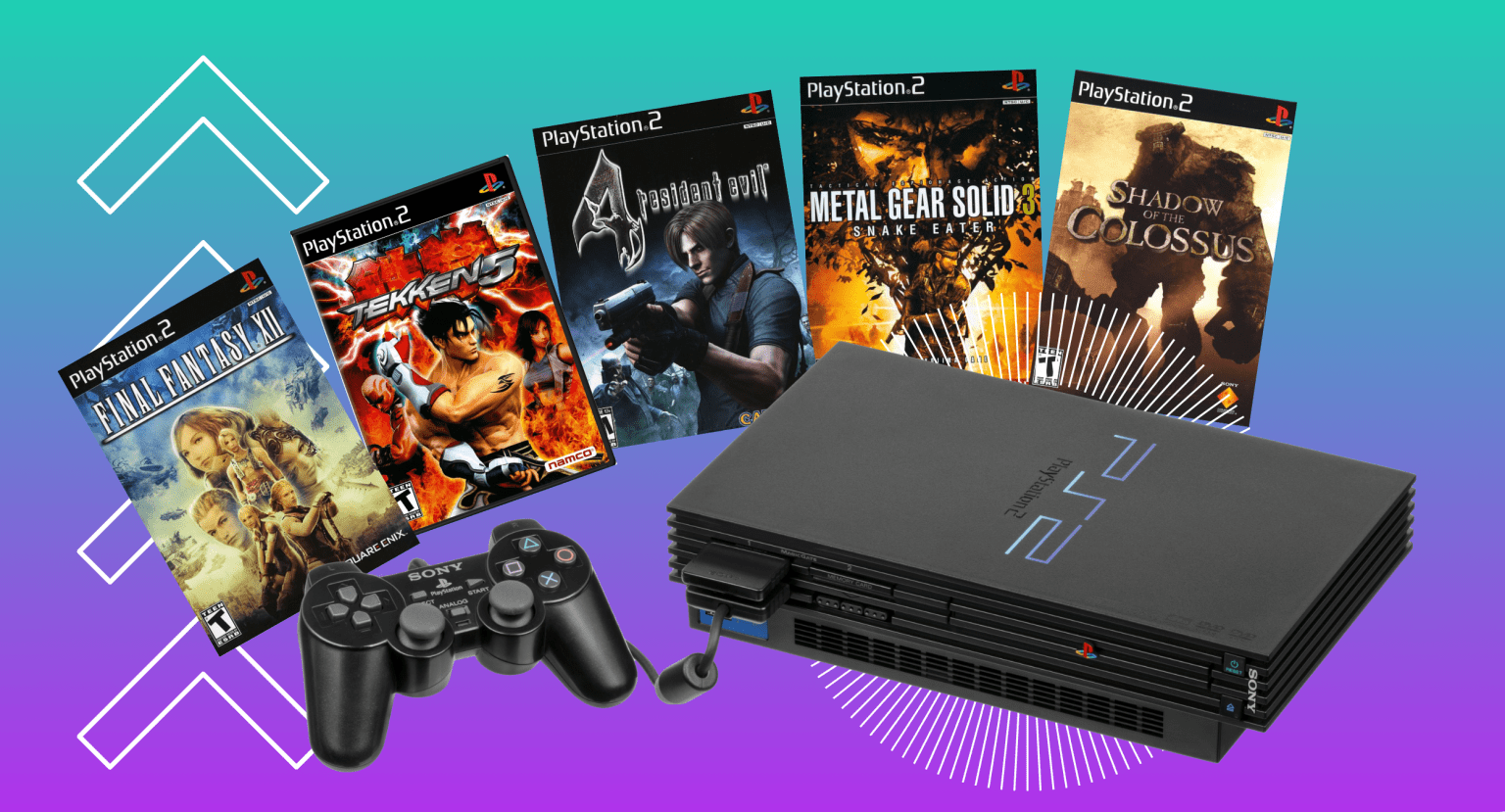








































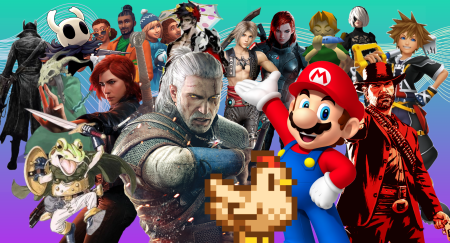
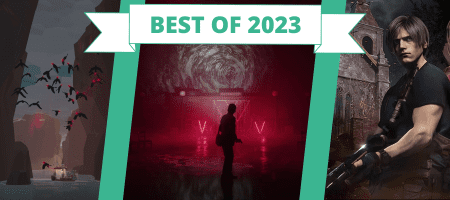
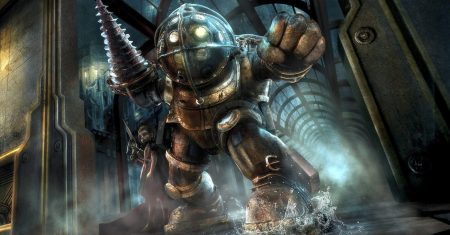
91 Comments
SSX Tricky was my favorite PS2 game. So much fun!
The fact that you don’t have SSX TRICKY on this list makes it a BOGUS LIST.
The first game that came with my scalped ps2 from a WM employee lol. So good. Wish the later SSX games were as good as that one.
Lol didn’t think to mention GTAsan Andreas, the best selling PS2 game of all time. With the most open world features till date even with current gen consoles.
Dragonball Z Budokai Tenkaichi 3 all day
Ratchet & Clank series. I love the weapons, music, and the easter eggs they had from other games that were created by Insomniac.
Burnout where you try and cause the biggest car wreck and when racing more points and speed by near misses on head ons while traveling in the wrong direction. I still have PS2 for this reason but the tv it was hooked up to , just died .
They need a remastered version of bunout 3
My favorites were the Crash Bandicoot series, Crazy Taxi, RC Revenge, Kya: Dark Lineage!
Here’s some of my favorites you didn’t mention:
-Kingdom Hearts 1&2
-Guitar Hero games (but especially the 3rd game)
-Soul Calibur 2
-Burnout Takedown and Revenge
All the Xenosaga games.
Why did it not have one of the rarest games ever made. As well as one of the most engaging stories and the mechs……
I remember renting xenosaga 1 for a month then going and buying it. To play number 3 I had to use my PC and an emulator
I’ve got the full trilogy for PS2, CIB!
Nobody I know bought them either! I still have all 3.
A loy of great ones have been mention already. Below were my favorites.
SOCOM Navy Seals 2
Medal of Honor Frontline
Fifa 2003
MLB 2004
Fight Night 2004
Madden 2005
Shadow of the Colossus is my top ps2 game by far. I have a couple things to say about what you said about it, but I won’t go too deep into them.
In terms of the camera, I’ve never understood why people have issues with the camera in games. To me, if I can’t see my character for a second or two, I still know exactly where I am and how to move, so it’s completely a nonissue. So maybe that’s just a skill issue on the part of 98% of gamers, or maybe I’m an anomaly. Who knows.
Additionally, in terms of controlling Agro, it’s a lot easier than people think. If you simply hold X while riding her, she will always move at the fastest speed she can in the area, and she will also automatically pathfind to a degree. You don’t have to spam X nor do you have to even touch the left stick to control her. There are a couple of exceptions, but for the most part, she does it on her own if you just hold X.
Ratchet and Clank was my go-to ps2 game
Need mercenaries playground of destruction and mercenaries 2 world in flames in PS3 version
My favorite are…. All of the Grand Theft Auto Games. Number 1# in my Book.
I agree like where’s GTA people it’s good 5 and god of war
Super Bombad Racing edged out God of War!? craziness
Rival Schools
Black
Gun
Need for Speed – Most Wanted
Driver
Tony Hawk 2 – Underground
SSX – Tricky
….just to name a few
A few that have been overlooked:
Tenchu; Wrath of Heaven – They took the winning formula from the PS1 games and refined it. Any game that has the motion capture of Sho Kosugi you know is going to be good.
Rogue Galaxy – Pretty much the Pinnacle of JRPG’s on the PS2. What is there NOT to love? Great anime inspired animation, moving musical pieces, a wonderful selection of characters, a fun way to unlock abilities, a wonderful cast of voice actors including Will Friendly and Steve Blum, a superb story… even the mini games were fun.
Jet Li’s Rise to Honor – Such an innovative attack system that harkens back to Double Dragon II, where to attack towards the right side of the screen, you pressed A and towards the left with B.
Demon Stone – Three characters are making their way through Faerun. A fighter, a rogue, and a wizard. Along the way you get to spend to upgrade their abilities. More of an action game than an RPG like you would expect from the setting, it rewards you with some of the guest voice actors like Patrick Stewart and Michael Clarke Duncan. This one was a bit of a sleeper, but definitely worth the weekend for playing and playing the same level with a different character to see how they and their skills would go through it.
Balder’s Gate II; Dark Alliance – The first game was ok. They really polished it up with the second. The characters are more diverse (like having a drow monk). The weapons and armor are now upgradable. The story helps move you along within the game. This one is certainly one of my favorites.
Where’s Fight for New York, NBA Streets2, NFL Blitz, SSX1-2 just to name a few.
If we’re talking about exclusives, where’s Gran Turismo 4?
Maximo, gta vice city, onimusha, devil may cry, Max Payne, mortal Kombat deadly alliance, mortal Kombat deception, and mortal Kombat Armageddon. And my 2 honorable mentions would have to be monster hunter and star wars Jedi knight academy
IGPX,DBZ Tenkaichi 3.Bloody Roar 3.KH2,DDR,Tony Hawk underground.
Bloody Roar 3,IGPX,DBZ TENKAICHI 3.DDR,Rouge Galaxy.Naruto Ultimate Ninja 3.
My favorites are The Suffering, Gex, SmackDown vs. Raw, GTA San Andreas, Manhunt… Those were all awesome games… Let’s not forget Jackass just for a laugh.
Wwe Pain ,Drangon ball z, Mortal combat,Downhill cycle race, Residential evil were too good even I’m wanting to play now a days for a full day
Gex is PS1
I guess Red Dead Revolver died or something
The getaway
Blood will tell
God of war
Shadow Hearts and it’s sequel are not just my favorite ps2 games, but my favorite RPGs ever made. I’m sad to not see them on many lists.
Def jam FFNY
Def jam vendetta
NFL street
NHL Hitz
Fight Night round 2
San Andreas
Midnight club Dub Edition remix
True Crime Streets Of NY
Nobody talking about God of War?!?♂️
RyGar , Chaos legion ,Bujingai
Gladius! No one ever seems to take about this game but it’s a classic!
I’m actually surprised Marc Ecko’s Getting Up: Contents Under Pressure wasn’t even mentioned, everyone else has listed my other tops, but this game was GOAT.
1.battlefront 2
2. Need for speed hot pursuit 2
3. The return of the king
4. Medal of honor rising sun
5. The hobbit
There are many but heres a few for me
Batman Begins
Bully
Def Jam: Fight for NY
Dragon Ball Z Budoki 1-3
Fight Night: Round 3
God of War
Grand Theft Auto 3
Grand Theft Auto: Vice City
Grand Theft Auto: San Andreas
Hitman Blood Money
Max Payne
Mercenaries
Scarface
Shadow of the Colosus
Tekken 5
The Godfather
WWE Smackdown! Here Comes The Pain
I liked your list the best especially smackdown here comes the pain
Mine would be yugioh capsule monsters duelist of the rose’s and the madden games be for EA ruined them with bugs
Mine is PS2 Konami’s Yu-Gi-Oh!
Capsule Monster Coliseum.
Why Someday, Somebody doesnt
ReMaster PS2 Games to Play on
Latest Stations or make Latest
Stations backwards compatible
is Beyond Me.
Def Jam vendetta and fight for NY was top of the line then GTA San Andreas
Great list everyone. Oh man. Dont forget Tokyo extreme racer?, Yes originally a Sega. Although so much better on PS2. An OG at it best.
Twisted Metal.
GTA San Andreas didn’t make the list? That completely invalidates this list.
Medal of honor frontline gta im glad its not on the list gta overrated jak i can name plenty of better games
Smugglers run
Kingdom hearts
Driver
Fantavision
for the record, we did have an internal miscommunication about who was going to cover kingdom hearts or kh2 and then nobody did and i have been in pain about this ever since we published this list
<3 Kingdom Hearts
Without a doubt, parasite Eve one
How the heck has no one yet mentioned tinesplitters
Also personally if there is multiple titles in a series it should be like
Final fantasy
GTA
Metal gear solid
And so on.
Also how is the list being compiled is it by amount of sales public vote? There can’t be a true top list of all time in gaming because everybody has different tastes in the games they play so everyone’s top 10/20 are wildly different.
Correct! These are our personal picks.
I see these alot and not once have I seen anyone mention Darkwatch. That was a great game. Should be remastered!!!
Midnight club dub edition… GTA San Andreas…… fight night 3…… metal of honor 1&2…….. Let remaster midnight club dub edition if agree say yes in put let bring it back M.C.D.E 2025
My memories were Burnout takedown and the Shadow hearts trilogy
Top Gun: Combat Zones
Meanwhile Dreamcast has games like power stone , House of the Dead , MSR , soul caliber shenmue and could be played online and flopped!! PS2 was most overrated console ever. Most of that top 20 are very average
Ur absolutely insane dude. PS2 was the greatest console ever. Cry some more cause ur crapcast sucked
Are you 12?
I never see any love for the Maximo series in these ps2 lists
-Prince of Persia:
The Sands of Time
-Tenchu: Wrath of Heaven
-DMC Series
-Canis Canem Edit/Bully
-Killzone
-MOH: Rising Sun
-Guitar Hero
Several of my favorites are already on the list; in my opinion, the Xenosaga Trilogy should be among them. Wow, I’d forgotten just how many great games came out for this amazing console.
Grandturismo 3 4
Black also one of the best shooter game
100%
God Of War (PERIOD)
God of War II (PERIOD)
Max Payne- (PERIOD)
Need For Speed 2 – Hot Pursuit
G.T.A. III
G.T.A. Vice City
G.T.A. San Andreas
MANHUNT
Scarface
The Getaway
… and I know there’s a few others but these rank among my faves. And yep – I STILL play them from time to time.
The original Sly Cooper trilogy! Exclusive to PS.
And older 3D Sonic games like Heroes and Riders.
My top ps2 games of all time would be:
#1). gta San Andreas
#2). The Two Towers
#3). The Return of the King
#4). God of War
#5). God of War ll
#6). The Punisher
#7). Resident Evil 4
#8). Scarface the World is yours
#9). The Thing
#10). Peter Jacksons King Kong
#11). The Godfather
Black
Dude, how could you NOT have “DARKWATCH” on this list man!!!!
Shadow of Rome
I have to add iss pro soccer and crash bandicoot games
You are all forgetting the best one need for speed underground 2
My favourite are the football games, there’s no Formula one 2001, Colin Mcrae Rally 3, LMA Manager 2003 and Man United manager 2005
Ummm… Tekken 5 yes, but what about Teken Tag Tournament?
This list is absolute bull. Not a single ratchet and clank, no Spyro, jak 2 instead of jak 3, dark cloud 1 instead of rogue Galaxy, no san Andreas or vice city. Absolutely bogus list.
Before COD blew up, there was SOCOM 2
Can’t believe nobody brings up the Simpsons hit and run
Also
GTA 3
GTA vice City
GTA San Andreas
No gta games? Who are you fooling?
Anything Rachet and Clank .
Medievil for ps2
Downhill Domanation
Why’s mortal combat shaolin monks ain’t on here I think it was the all time best Game really fun to play
The best 19 games of ALL time? Pick one game in the series, don’t be lazy! You should always specify this is your personal list as it is always an opinion.
Marvel Ultimate Alliance was a supper fun to play a very interesting game to learn as well be nice to bring back the game back to life.
Rogue Trooper was a great game and different. I think it be great to have a remake a really fun game.
So Socom gets no love from Sony..
MINE WAS THUNDERSTRIKE OPERATION PHOENIX THE HELICOPTER COMBAT SIMULATOR GAME
Some forgotten gems like Warship Gunner 1 & 2 and the SOCOM series.. especially SOCOM Combined Assault.. PTO IV, Ace Combat 4 and 5. Just to name a few
Drakengard
Hunter The Reckoning: Wayward